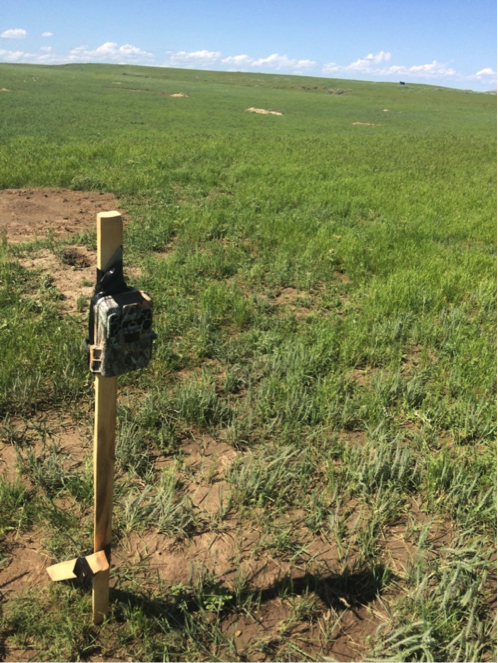
Scavenging Shot Prairie Dogs And Gophers
Block title
 By: Mike McTeeResearcher
By: Mike McTeeResearcherAvian Ecology
We seek to understand how birds use the habitats available and how that will change as we work to create more diverse plant communities. We also host researchers that document migrations of raptors and songbirds across MPG.
In this section of the research pages, you will find links to reports and updates from all the researchers involved with avian ecology, posted chronologically. The links will show you more in-depth reports on our findings. The three main projects covered here are:
Songbird Counts- A grid of sampling points covers MPG with 560 points. We visit each point 3 times a year, once in winter and twice during the songbird breeding season. We record, by ear or by sight, all the birds near that point for 10 minutes.
Songbird Banding- The University of Montana Bird Ecology Lab, UMBEL, runs several trapping stations at MPG as part of their regional songbird monitoring program. UMBEL sets up very fine nets that are nearly invisible to birds in brushy habitats. Songbirds fly into the nets and become entangled. The researchers take the birds from the nets and affix a numbered band to their leg before releasing them.
Raptor Research- The Raptor View Research Institute monitors raptor populations on MPG and counts raptors that migrate past MPG in the spring and fall. Raptor View researchers have placed transmitters on osprey and golden eagles that use the Bitterroot Valley.
Along with our colleague, Dr. Brian Hiller at Bemidji State University, we set up game cameras near 89 carcasses at eight ranches and private properties across Montana. The Journal of Wildlife Management just published our work, but here’s a rundown of the main findings.
Scavengers fully consumed 66% of the carcasses and partially consumed 9% of them. We observed five species of mammals and nine species of birds, like northern harriers (pictured below). Birds ate 84% of the carcasses, and mammals ate the rest. Of the birds that scavenged, half were raptors and half were corvids. We were surprised to see burrowing owls scavenging. They often feed opportunistically, but to our knowledge they hadn’t been seen scavenging prairie dog carcasses.
Carcasses didn’t last long. On average, scavengers like the fox below fully consumed or carried away carcasses in 24.5 hours.
In White Sulphur Springs, MT, common ravens scavenged nearly every carcass even though hawks soared overhead. The presence of the first raven at a carcass may have lured in more ravens, potentially speeding up the rate of scavenging.
Unfortunately, there’s no “free lunch.” Our previous research in Wildlife Society Bulletin (summarized here), showed that even if lead bullets pass through a ground squirrel, tiny fragments of lead can be left behind (X-ray below). If a scavenger ingests those fragments it may be poisoned. Shooters can eliminate this risk and feed scavengers “clean” carcasses by using nonlead ammunition.

About the AuthorMike McTee
Mike McTee is a researcher at MPG Ranch and the author of Wilted Wings: A Hunter’s Fight for Eagles.
Mike shot his first weapon before he could recite the alphabet. Now, understanding weapons is part of his job. His career took this trajectory after Mike gained a B.S. in Environmental Chemistry. Curious about potential pollution at a historic shooting range at MPG Ranch, he earned an M.S. in Geosciences studying the site. Strangely, the sulfur inside the trap and skeet targets posed the main threat, not the lead in the shotgun pellets. Regardless, lead contamination soon grabbed Mike’s focus. Each winter at MPG Ranch, biologists caught eagles that had lead coursing through their veins. Lead can cripple eagles flightless and even kill them. Mike soon initiated studies on scavenger ecology and began investigating the wound ballistics of rifle bullets, the suspected source of lead.
Mike often connects with the public through his writings and speaking engagements, whether it be to a local group of hunters, or a gymnasium full of middle schoolers. He frequently writes about the outdoors, with work appearing in Sports Afield, The Drake, and Bugle. When he escapes the office, Mike explores wild landscapes with his family, always scanning the horizon for wildlife.
Sign up for Montana’s Nonlead Newsletter (see past editions).
Mike shot his first weapon before he could recite the alphabet. Now, understanding weapons is part of his job. His career took this trajectory after Mike gained a B.S. in Environmental Chemistry. Curious about potential pollution at a historic shooting range at MPG Ranch, he earned an M.S. in Geosciences studying the site. Strangely, the sulfur inside the trap and skeet targets posed the main threat, not the lead in the shotgun pellets. Regardless, lead contamination soon grabbed Mike’s focus. Each winter at MPG Ranch, biologists caught eagles that had lead coursing through their veins. Lead can cripple eagles flightless and even kill them. Mike soon initiated studies on scavenger ecology and began investigating the wound ballistics of rifle bullets, the suspected source of lead.
Mike often connects with the public through his writings and speaking engagements, whether it be to a local group of hunters, or a gymnasium full of middle schoolers. He frequently writes about the outdoors, with work appearing in Sports Afield, The Drake, and Bugle. When he escapes the office, Mike explores wild landscapes with his family, always scanning the horizon for wildlife.
Sign up for Montana’s Nonlead Newsletter (see past editions).
























